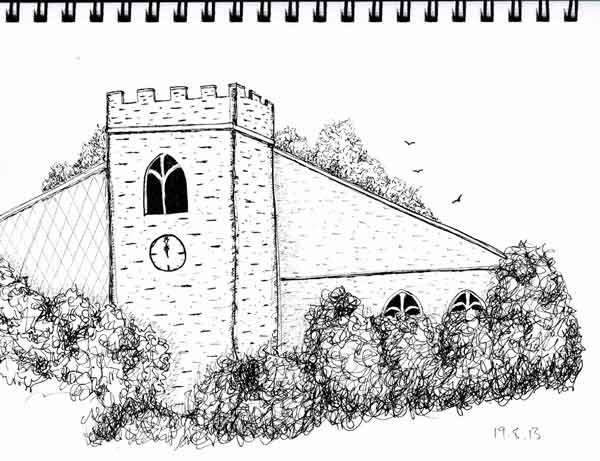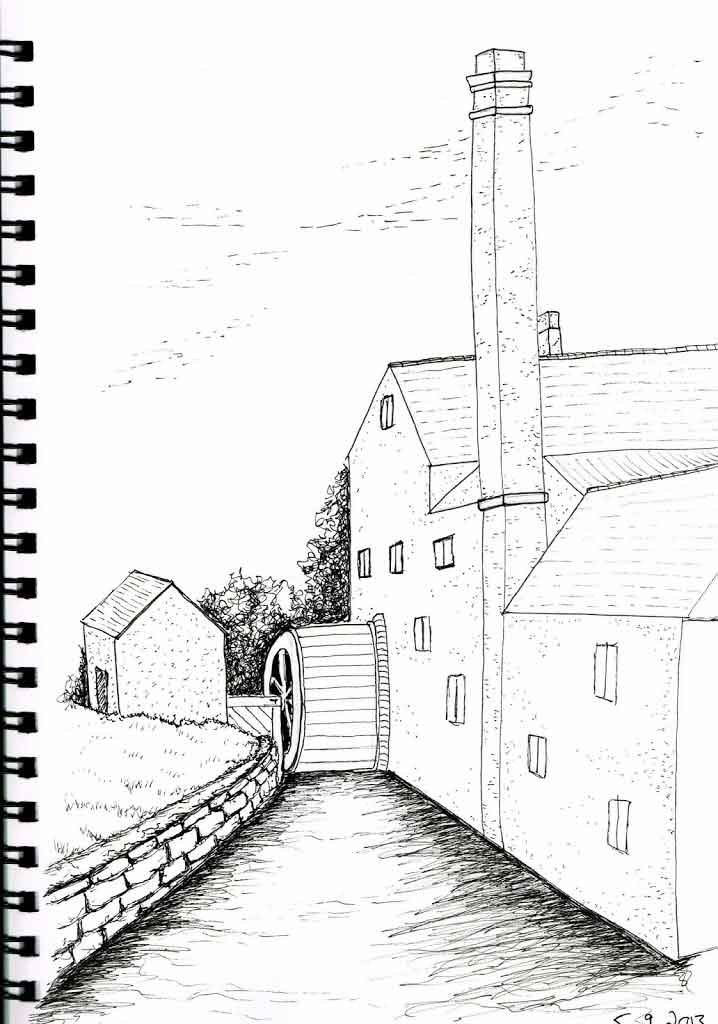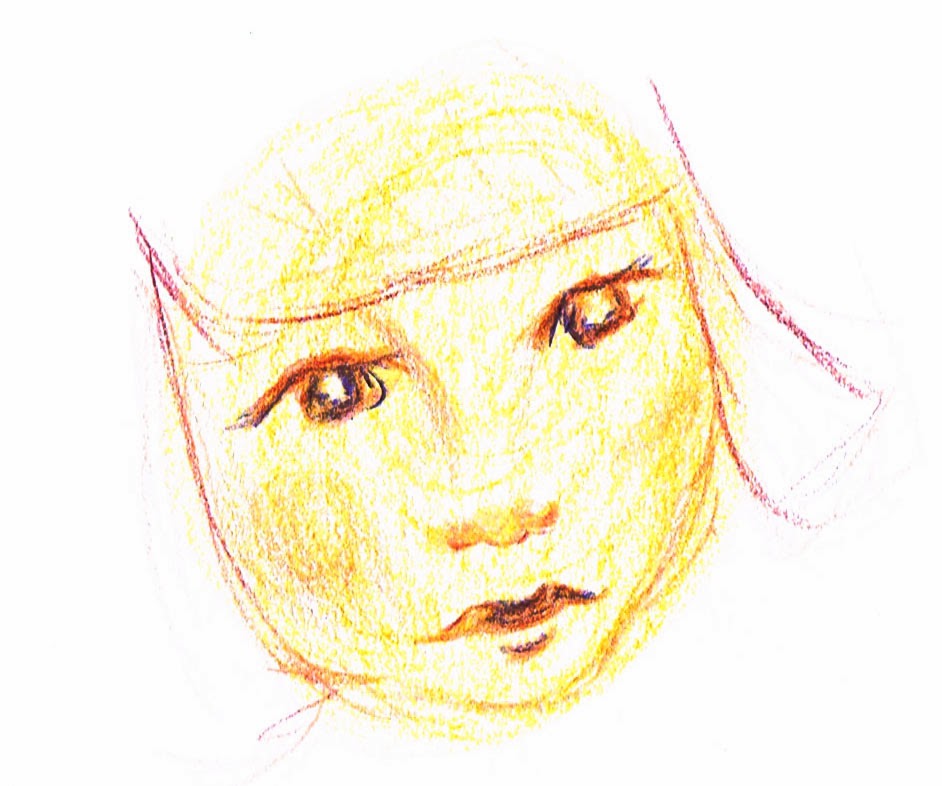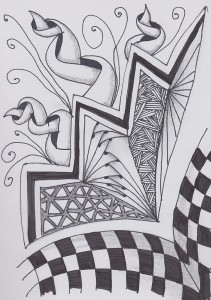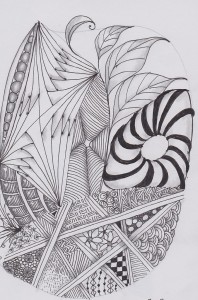Permission to be a beginner
 |
| Mixed media painting of quirky animals produced in the online class 'Lifebook 2014' |
I have been watching my children learn new things, as only children tend to - with joyful abandon. A child is free from judgement and gives themselves permission to be a beginner. They are children, therefore, by default, they are beginners at everything and we have little or no expectations of them. When do we stop granting ourselves the same freedom? Learning new things is like breathing to me. I think it is healthy and that we actually all do it continually, consciously or otherwise. But as adults we have much higher expectations of ourselves, even if we are trying to do something we have never done before. So when we pick up a paintbrush/golf club/musical instrument for the first time in our adult lives we can be so easily discouraged by those first attempts. Poor first attempts are inevitable. Actually, they are an entitlement. We have the right to play and experiment with something new, just like a child would. Turn out something as atrocious as you please - it may be the only way to getting to producing something you actually like! Jane Davenport advises that you 'trust the mess'. I see what she means. You start drawing or painting. You don't like it. Sigh. But it might just be that if you can figure out what you don't like you will have a go at changing something. Nothing to lose, right? That 'figuring out' and experimenting is the way to learn. There don't seem to be any short cuts. In an interview with Ian McKendrick (which you can hear, here) watercolour artist David Bellamy has similar advice for beginners. He suggests we should just "Get out and do it... accept that you are going to make a mess to start with". Hearing David talk about his own early work was a reassuring reminder that even the accomplished started out at the same sort of point as we did. So let's go and try something new and be prepared to do it badly to start off with. Is there something you have considered trying to learn? Does fear of being bad at it put you off trying?
"Never compare your beginning to someone else's middle" John Acuff
Making art without attachment
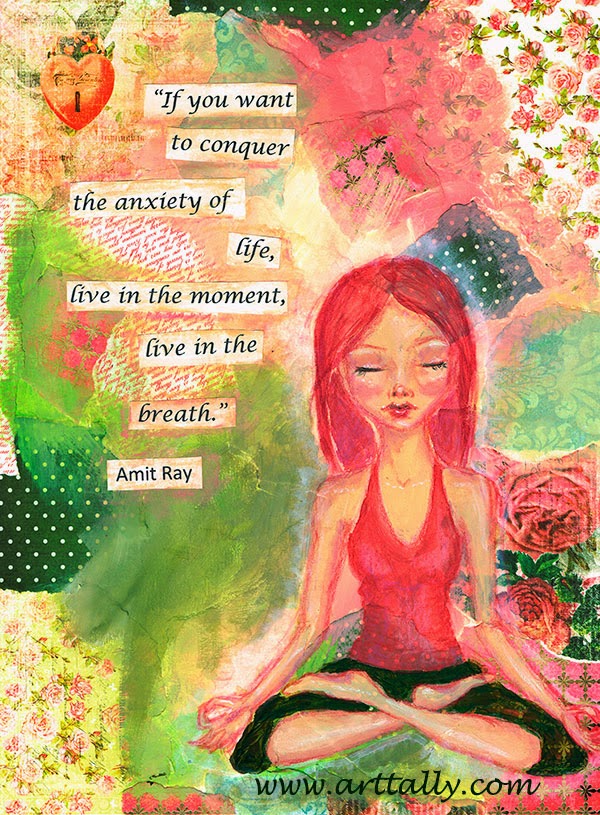 |
| Mixed media painting created in the online class Lifebook 2014 |
There is an art show that takes place annually a few hundred metres from my house. A while ago I decided I would like to submit something to that show one day. Since then I have eagerly enrolled in many an online class and done a lot of work in my art journals and sketchbooks. But something happens when I sit down to a separate piece of good quality paper or a new canvas. The pressure of trying to produce something I might be able to submit to a formal art show is paralysing. Being too attached to the outcome suffocates the creative process. Luckily I got a glimpse of the alternative in a recent Lifebook 2014 lesson. I really enjoyed this particular lesson video, but to be perfectly honest, the style of the teacher's finished piece didn't resonate with me. This turned out to be the biggest gift of the lesson. It meant that I could take the prompts, the ethos, the techniques from the lesson but let my own artwork unfold with no attachment to or expectations of the finished product. As a result I found the process delightful, and absorbing. I even ended up with something I really liked. I have learned a lot from teachers whose finished pieces seem to sing to me. But somehow, if you really love what they have done, your own copy is quite likely going to be a bit of a disappointment. Now I understand just how much can be gained from a teacher whose style is quite different from your own. If you are not trying to emulate a particular style you are open to a whole world of possibilities. And if you don't start out with a vision of your finished work, you have removed a criterion by which to judge (and therefore disappoint) yourself. I am learning to create for the joy of it, not for the finished product, and that in art as in life, everyone has something to teach me.
The delicate art of giving and receiving feedback
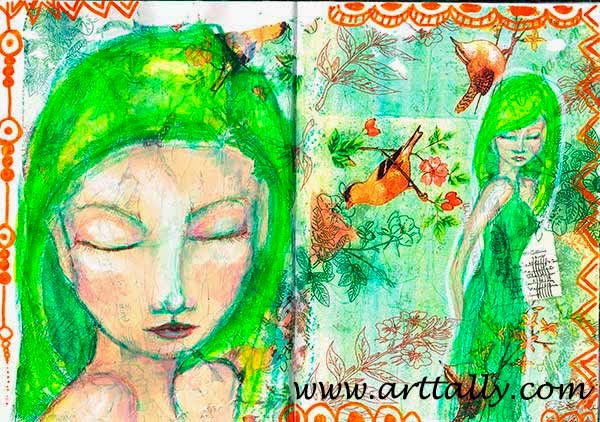 |
| Mixed media journal page created in Jane Davenport's online class 'Create Emotion' |
Feedback is a great way to learn. We all need it...but can we take it? As you may know, I have something of a mixture of fear and reverence when it comes to watercolour. My early experiments had given me enough confidence to think about taking a class. You know, an actual live in person class... Remember those? It was an evening class which already gave me pause. I take it as an indication of my enthusiasm and commitment that I signed up in the first place since, typically, by 7 p.m. I am not good for much other than curling up on the sofa in front of the TV. Anyway, I dutifully (and nervously) packed up the necessary supplies... An extensive list, as watercolour can require a fair bit of paraphernalia, and having rushed around feeding the family early, I dashed off to my class. In the second lesson, we were painting yachts on the sea. The teacher would demonstrate at the front, then walk around the class a bit while we had a go at replicating what she did. When she got to me she paused. "Hmm," she said. Uh-oh. Then she whisked the paper off the easel, held it aloft and called everyone's attention in order to discuss the problems associated with introducing too many colours, and not properly integrating them. A perfect example of this error provided by my good self. It's okay, I'm a big girl, we are a small intimate group (of strangers who met for two hours last week). I can handle it. Everyone is going to make mistakes and we will be doing this with someone else's work next... Actually no, just mine...it turned out. Too little water, look at this everyone, ...not enough paint.... Typical composition error... etc, etc. Outwardly I think I handled this admirably. You know, a bit of grave nodding, hopefully looking detached but interested. My inner child, however, had her arms crossed very high over her chest, thunderous eyes looking up through lowered brows, bottom lip thrust forward. I think she may even have stamped her foot. Well, by the third time my painting went flying off the easel I could see her point. She thought I should tell the mean lady that Lovely Jane does this so much better. Isn't it customary to begin with a random platitude? Perhaps even a "very-nice-dear-but-perhaps-you-could-try...." ? Feedback is so important, it is such a good way to learn. But I think that giving helpful feedback might be even harder than receiving it. I think I might stick to the safety of my online classes till I have acquired a bit more skill, or a thicker skin. I'll aim for both.
Don't know what to draw? Here is a possible solution...
 |
| Week 18 theme 'Celestial Body' for the 52 week Illustration Challenge |
Sometimes, that blank page is an insurmountable problem when you are learning to draw. However, I have come across a possible solution for the problem of trying to figure out what subject to choose. Hurrah! I happened upon the 52 week illustration challenge on Facebook, and I am so glad that I did. It is open to all ages and skill levels and involves posting your illustration of the week's given theme. You can check it out here, if you want to join in or find out more. There are so many benefits to this challenge. My top three are:
- The point of the exercise is to do more drawing and painting. This gives you a reason to produce at least one illustration per week
- No more excuses about knowing what to draw because the theme is given to you. Just eliminating some of the possibilities presented by the blank page can be a tremendous help.
- Being given a theme encourages you to think about drawing something different from your usual subjects. It's so easy to get stuck in a rut and draw only within your comfort zone.
The theme we have just done was 'celestial body'. It was awesome to see so many different ideas emerge from one theme - all that creativity is so inspiring!
Three ways to get started in watercolour
I have something of a love-hate relationship with watercolour. I have owned a set of watercolours for over 10 years. Mostly they encouraged me to buy more books on how to paint with watercolours, but actually using them has been the hard part.They are daunting. Sounds so simple. Just add water. In fact it is the water that is both the charm and the vice here. It is because of the water that the colours blend and pool the way they do. It is because of the water that control of the colour is so elusive.I have a few suggestions if you are thinking of dipping your toes in the water...colour... so to speak....The first is to let go of trying to control the watercolour and just playing for a while, figuring out what the water and paint will do together. In fact, there is an entire online class I found that is based on this premise. It's by Michelle Brown and it is called 'Loosen Up'. So obviously when I heard about it, I knew she was talking to me.
The second is to let go of the idea of trying to produce something like the classic chocolate box landscape or seascape entirely in watercolour and use it more simply, as a colouring medium. Start with a permanent pen (i.e not water soluble) line drawing and then use the watercolour to fill it in like an illustrator might.Thirdly, keep it simple. Try painting a single subject with no background, like a flower or a pear. I took Martha Lever's Color Drop Flower class. In fact it was the first time I actually used my watercolour set in 10 years. Martha makes it all seem quite approachable.Watercolour is actually quite glorious. But it takes faith in the medium and quite a bit of patience to find this glory.
Variety is the sugar and spice of life
I have been loving being a part of Lifebook 2014, one of the (too) many online classes I have signed up for this year! One of the best things about Lifebook is that you get to see a variety of teachers, which means you get exposed to things you might not ordinarily have chosen. It is easy to get stuck in a rut, and stay in your comfort zone, probably without even noticing you are doing it. This is something I know I do in all things, not just art!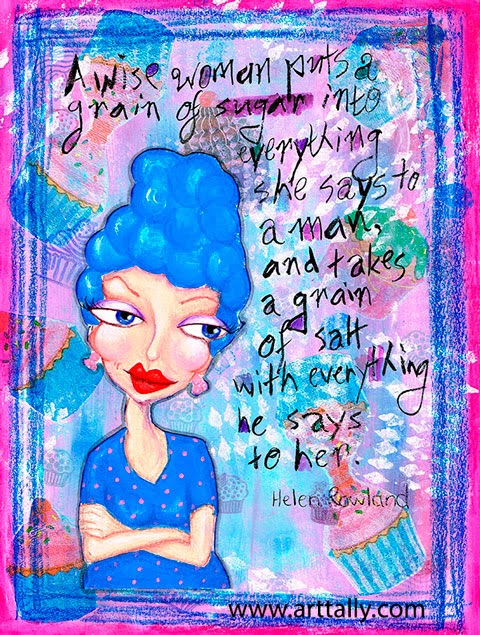 Earlier this year, Marieke Blokland did a 'sweet' lesson - I'm not being trite or patronising - really, it was about drawing candy and a Sugar Diva. Now that could be my middle name, come to think of it...
Earlier this year, Marieke Blokland did a 'sweet' lesson - I'm not being trite or patronising - really, it was about drawing candy and a Sugar Diva. Now that could be my middle name, come to think of it...
Anyway, it was a wonderful combination of things I am used to, like drawing faces or creating layered mixed media backgrounds, and things I haven't even considered, like eyes that stick out wider than the head and fairy floss hair.
I have been fascinated by the process of learning to draw, learning new skills, but this helped me remember that art is fun, and that one of the best reasons for doing any of it is to play. I also remembered that my first drawing inclination was actually towards cartoons.
Marieke's wonderful lesson gave my inner zany cartoonist a nudge... about time too, she was starting to feel neglected...
Observation: fundamental drawing principle and exercise in mindfulness
Disclosure: This post may contain affiliate links. That means if you buy something we may possibly get a very small commission at no extra cost to you, and we thank you.
Cathedral pen sketch following Mark Linley's instructions on buildings in
One of the most important parts of learning to draw is the power to observe. Actually, it is becoming apparent that the best drawings come from spending more time looking at your subject than at looking at your drawing in progress. So important is this skill that some art teachers make you draw without looking at your paper at all. This is fun, obviously, and you end up with some kooky whimsical drawings, but the point is that the better one's power of observation, the better the drawing, regardless of subject.
And that is important I think. In his jolly good book, 'How to draw anything', Mark Linley advises that one should learn to draw everything well and then specialise. Very liberating that would be too... Imagine being able to draw whatever crazy thing pops into your head...
Water mill pen sketch following Mark Linley's instructions on buildings in
However, the thing I probably underestimated is that not only is this good drawing practice but it is also an exercise in mindfulness. In order to carefully study something, to notice the way the light falls, to observe the shapes as they actually appear and not as you think they are, you need to be truly 'present'. Being present in the moment allows you to notice the joyful minutiae of life. If you have ever taken a walk with a three year old, you will know how very many minutes can be happily wiled away engrossed in the examination of every leaf, stick and bug on the pathway. I am finding that drawing is doing much the same thing for me - it can be completely absorbing.
Being present in the moment and delighting in the simple things is what the experts tell us is a pathway to happiness. Mindfulness has been shown to be helpful for stress, anxiety and depression. I'm all for learning to meditate and taking mindfulness training. But, I couldn't be happier at the realisation that it need not be too complicated - that, in fact, a few moments of stillness and calm would seem to be a fairly effortless by-product of the joyful practice of drawing.
Altered books - recycling or vandalism...?
"Eek!"I am peeping out of the cracks in the fingers of my hand that leapt reflexively to my face upon watching Lovely Jane 'altering' a book for art journaling, in an online class. My Inner Librarian fainted when she witnessed the removal of some of the pages of an old picture book, so fortunately she can't see gesso and acrylic paint being slathered all over the remaining pages right now.
You see, I have always had the deepest respect for Books. Not for me, the dog-eared page corners... and notes scribbled in margins.....? Heaven forbid! No, no, my deep reverence for the printed word, ingrained since childhood, dictates that I never sully the book.
On the other hand, it does make good sense to take something old that might end up on the rubbish heap or recycled into toilet paper and give it new life and purpose as an art journal. A more dignified end...surely? In fact, not an end, but a new beginning, and I, of all people, can't argue against reinvention. It makes sense , I see that. Pages must be removed so that when those that remain have been thickened with paint, gesso, and collage, the book can still close properly. And of course, anyone intimidated by that blank page will understand the appeal of having an already 'imperfect' page to begin with, as a spring board, somewhere to start. I'm sure my Inner Librarian could raise some counter arguments but right now she is looking for her Xanax. My Inner Child however, is quite delighted with the idea and definitely thinks I should give it a whirl.
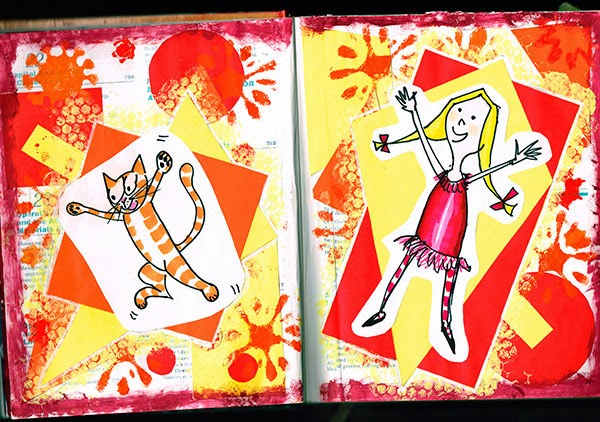 |
| One of my first altered book pages |
So is altered 'bookery' recycling or vandalism? It has taken quite a few months of internal debate to settle this issue within myself. But, when I was clearing out old editions of accounting textbooks, it seemed to be a sign. What a perfect exercise for me. Plastering a new life over the old one, as it were... Well, how could I not?
So here are some pages that were once all about costing models and budgeting but are now hosting colour, joy and playfulness...
 |
| The cover of an altered book art journal... hard to believe this was once an accounting textbook! |
So I'm definitely warming to this whole concept of using an altered book. My only issue with this first one is that the paper is way too thin. Usually gesso makes up for poor paper quality, strengthening whatever paper is there so that it can take the painting and stamping and stenciling that one might feel called to do. Sadly though, this paper is just that little bit too thin, even with the gesso. It is manageable as you can see above, but just not as pleasurable to work with as it might have been. Something to bear in mind for next time.
I did have enormous fun with the cover though.... My beloved creams, lots of texture and a butterfly. Now that's more like it!
What is the purpose of creativity?
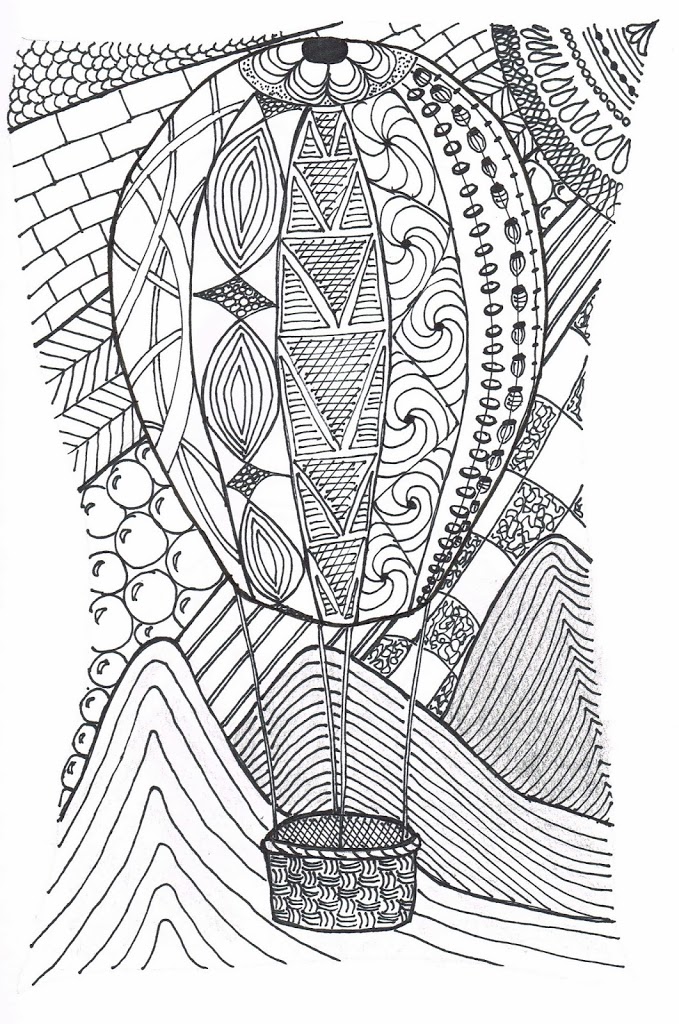 One of the things that really troubled me, and particularly so when I first noticed this urge to start learning to draw and paint, was, what is the point of it all? I would feel this tickle of excitement, and perhaps a naughty giggle when I thought of doing just what my five year old daughter was doing. That rather fierce voice in my head would start up sternly..."What's with all the doodling?
Have you forgotten you are an accountant?
Shouldn't you be doing something useful... like perhaps, your actual job? What is the purpose of this creative output?"
One of the things that really troubled me, and particularly so when I first noticed this urge to start learning to draw and paint, was, what is the point of it all? I would feel this tickle of excitement, and perhaps a naughty giggle when I thought of doing just what my five year old daughter was doing. That rather fierce voice in my head would start up sternly..."What's with all the doodling?
Have you forgotten you are an accountant?
Shouldn't you be doing something useful... like perhaps, your actual job? What is the purpose of this creative output?"
I have been a practical person my whole life. In fact I have been a creative person my whole life too. I realise now, that while it might seem a little counter-intuitive, creativity and practicality, or at the very least pragmatism, are strongly related. In Lilian Wissink's helpful book, 'The Creative Seed: How to Enrich Your Life through Creativity' she explains,
"Experts see creativity as a learnt ability to experiment time and time again and to problem solve until we get to a desired outcome. This process is practical, not mysterious."
So perhaps every creative activity is improving our imagination, willingness to explore and experiment, trust in our ability to think on our feet and find an innovative solution. In addition to this practical skill building, Lilian makes the other very valid point that we tend to be so focused on successful careers in our busy lives that we forget about, and undervalue the importance of, spending time doing something simply because it is fun.
 Creativity is much discussed in both business and education worlds. One of my favourite experts on the subject is Ken Robinson, a totally engaging speaker - you can hear him speak here: http://www.ted.com/speakers/sir_ken_robinson.html
Listening to Ken Robinson did help me get over these strange feelings of guilt or perhaps even shame at wanting to do something so apparently childish and unconventional. In fact, I now seem to be pretty well convinced that it is something most of us are missing out on. So... to the drawing board.... and beyond!
Creativity is much discussed in both business and education worlds. One of my favourite experts on the subject is Ken Robinson, a totally engaging speaker - you can hear him speak here: http://www.ted.com/speakers/sir_ken_robinson.html
Listening to Ken Robinson did help me get over these strange feelings of guilt or perhaps even shame at wanting to do something so apparently childish and unconventional. In fact, I now seem to be pretty well convinced that it is something most of us are missing out on. So... to the drawing board.... and beyond!
"The purpose of art is washing the dust of daily life off our souls." Pablo Picasso
The obstacle of the blank page....
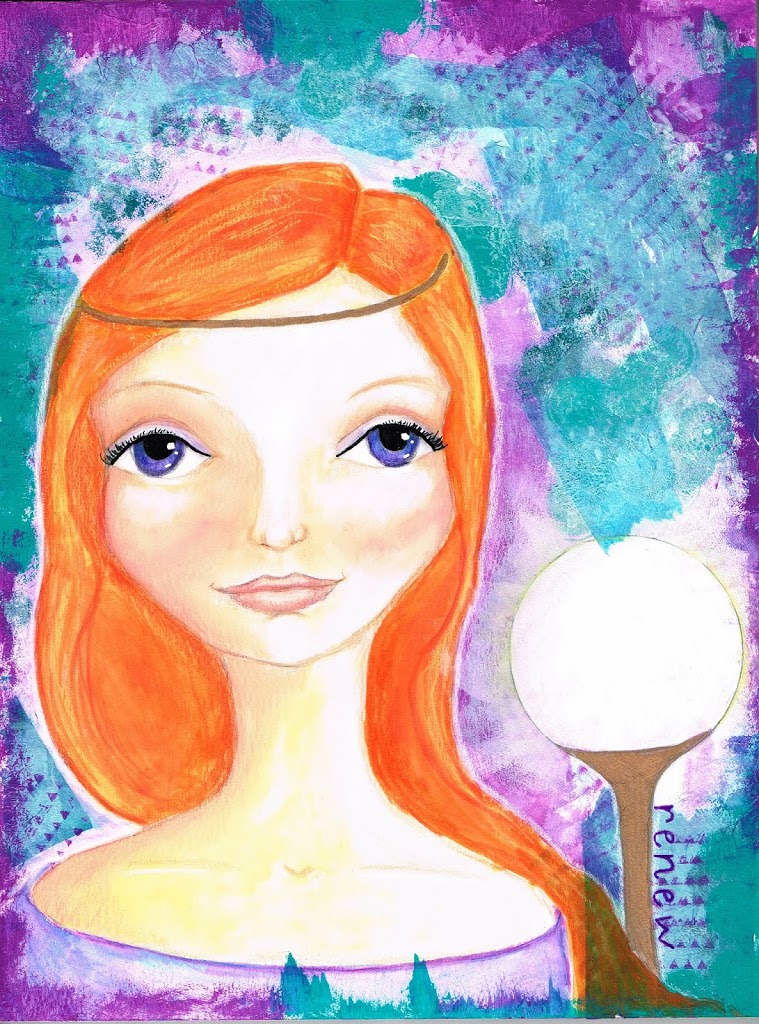 |
| Week 1 from Lifebook 2014 : My Inner Artist Guardian |
Now, what to draw? And in what style... realistic, whimsical... something else...?
The Wonderful World of Online Art Classes
I joined Jane Davenport's glorious school for creative souls, a while ago. I am so pleased that I have found Lovely Jane. Mostly I was so pleased to have found other people like me - all wanting to learn to draw but not really knowing how or where to start. I signed up to the Draw Happy Workshop and never looked back.
Watching Lovely Jane's fun videos in this introductory workshop and doodling away this little face appeared. I know its a funny little quick sketch, but it was a bit of an 'aha' moment for me. Everything seemed a bit easier, more possible and much more fun. As soon as I saw this little face staring at me I signed up to Jane's next class, Supplies Me, to learn more, and have been taking online classes ever since.
That was over a year ago, but it was the beginning for me. This year I have joined Lifebook 2014 and I am so excited about it! Seems like a jolly good way to help me put regular hours into my 10 000 hour endeavour. Will post my first week's work for Lifebook next.
Learning to exhale with Zentangle
I've spent so much of my life in the world of business and economics, and there is a part of me that loves that. It can be exciting and dynamic. But much like many other parts of life (juggling work, parenting, domestic chores, fitness, etc.) it seems to me to be all 'inhale'. 'Exhaling' seems increasingly tricky. I have been learning to meditate for many years, and think that it is likely to be something I continue to work on for the rest of my life. I don't know about you, but I find as a busy, active person, that sitting still and trying to just 'be' can be frustrating and sometimes impossible. It can be about as soothing and effective as the well meant words, 'don't panic', offered to an hysterical woman.
I have discovered the delightful art of Zentangle, and this seems to be an easily applied salve to the troubled mind. There is no pressure of colour choice (usually black pen, Sakura Pigma Micron, for preference) and no possibility of making a mistake (the art is non-representational). Beautiful patterns emerge from the repetition of simple lines and strokes. Each tangle is supposed to be small (3 1/2 inch square), making it quick to complete. I must admit I enjoy it so much that I have done tangles of all sorts of sizes depending on available time and mood!
Zentangle artists seem to be among the most generous, I think. A quick Google search will turn up an abundance of reference material for a beginner, and with just a few simple pointers, it is easy to get started. The first stop would have to be www.zentangle.com to see the creators of Zentangle (Rick and Maria Thomas) and hear their explanations of the ethos of Zentangle. The site also offers beginner's kits, and other resources, as well as a list of Certified Zentangle Trainers in your area.
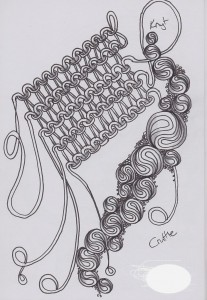 |
| 'Knyt' and 'Cruffle' from the instructions on tanglepatterns.com |
I think my favourite Zentangle resource would have to be Linda Farmer's site www.tanglepatterns.com where there is a comprehensive library of step by step instructions for different patterns, generously shared by Tanglers everywhere. I really enjoy learning a new pattern and seeing how a potentially complex design is broken down to its simple parts.
Whether it is to de-stress, to warm up and get into the art 'zone' or for no reason at all, I think Zentangle really is for everyone.

